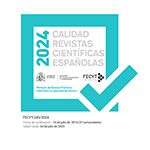Spelling in the University Education level: a reality that requires the reflection of students and the involvement of teachers
Abstract
Until recently we have considered that spelling by students could only be found at pre-university educational levels. But it is increasingly evident that they are also present among students in University level, who should have overcome them.
Different writings produced by university students (academic papers, exams, online consultations or tutorials, etc.) have a lot of spelling mistakes that are a serious inconvenient in the acquisition of the linguistic communication competence. Therefore, evaluating spelling mistakes is an additional task for teachers, as guides in education process, which until present days had been considered and exclusive responsibility of teachers at the pre-university educational stages.
Although this panorama is worrying, it is even more so when we analyze the writing of the university students of the Education's degrees (Preschool and Primary Education), who have to learn about how to teach and transmit educational content to children and young people (between 6 and 16 years).
It is important that university teachers make practices and training about spelling in their classrooms, as an urgent issue. The present study confirms that ignorance is not the sole culprit: students do not pay attention and are not interested in this aspect of Grammar when they applying orthographic rules in their writings.
For that it is important to analyze and to describe the main mistakes of our students made as examples in the way to propose a correct academic writing and spelling.
Downloads
Article download
License
In order to support the global exchange of knowledge, the journal Didáctica. Lengua y Literatura is allowing unrestricted access to its content as from its publication in this electronic edition, and as such it is an open-access journal. The originals published in this journal are the property of the Complutense University of Madrid and any reproduction thereof in full or in part must cite the source. All content is distributed under a Creative Commons Attribution 4.0 use and distribution licence (CC BY 4.0). This circumstance must be expressly stated in these terms where necessary. You can view the summary and the complete legal text of the licence.










